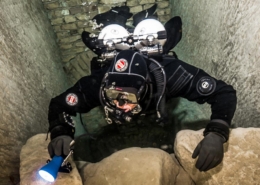Liftbag or SMB?
By Rick Kruzel
A surface marker and guideline are an essential part of a tech diver’s kit. Most people use either a lift bag or an SMB (surface marker buoy) as the marker. A reel or finger spool are two options for carrying and deploying a line.
The reasons for carrying these items are many. If diving in a current, divers often deploy the marker, attached to the line, from depth and conduct their ascent while drifting. The marker on the surface lets the boat crew know where the divers are. It also gives divers a stable reference for the ascent. Divers can launch the marker if they get blown off the dive site unintentionally. Even if no current is present, divers can use the marker as a makeshift up line if they cannot find the proper ascent line. Besides using the lift bag or SMB to rig an ascent line, it can be used as an alternate buoyancy device in an emergency.
Lift Bag
A lift bag is usually a bag with an opening at the bottom. They come in various sizes, determined by how much lift they provide. The primary use of a lift bag is to lift heavy objects from the bottom to the surface. In the early days of technical diving, they were pressed into service as marker buoys for divers because we had nothing else.
The technique for deploying a lift bag as a surface marker is:
- Remove bag from storage space
- Remove reel from storage space
- Attach line from reel to lift bag
- Add air to lift bag
- The bag goes up to the surface
There are several disadvantages to using a lift bag as your surface marker. First, lift bags are big and bulky. They take up space and can be hard to integrate cleanly into your configuration. Next, if it is a model with an open bottom, it is susceptible to broaching. That is, the bag pops out of the water when it surfaces, air escapes through the open bottom, and it sinks back to the bottom. Most importantly, lift bags don’t ride very high out of the water, making them difficult for boat crews to spot.
Surface Marker Buoy (SMB)
Some SMBs are quite small and have no overpressure relief valve, hence they cannot be deployed from depth. They are designed to be inflated once the diver is on the surface to signal the dive boat. These “safety sausages” are not suitable for our purposes as tech divers. I’m not referring to these “surface use only” models in this article. We are interested in SMBs that are specifically built for inflating at depth. They have overexpansion valves to vent expanding air during ascent. They are long and thin so that they stick up out of the water. SMBs are usually small enough to roll up and store in a dry suit pocket (even with a finger spool attached). SMBs are usually completely closed or have some sort of air trapping design so that once air goes in, it does not come out until you let it out. This eliminates the broaching problem common with lift bags. SMBs come in sizes ranging from 1 m/3 ft. tall to 2 m/6 Ft. tall. They are much easier to spot from a boat than a lift bag.
The technique for deploying an SMB is:
- Remove SMB (with spool attached) from drysuit pocket
- Unroll SMB
- Add air to SMB
- SMB goes to surface
Reel vs. Spool
A word about guidelines is in order. Once you’ve decided on which marker you want to carry, how should you deploy it? There are a number of ways, including standard reels, finger spools, or even the classic Jersey Upline. In my opinion, there is no clear winner in the reel vs. spool debate. They each have advantages and disadvantages. My advice is to try both and decide for yourself.
Reels
Advantages
- Hold more line (can be deployed from greater depth)
- Easier to handle (has a frame, handle, knob)
Disadvantages
- Bigger/bulkier
- Takes more time to deploy
Spools
Advantages
- No moving parts to jam
- Smaller than a reel
- Quicker to deploy since it can be left attached to SMB
Disadvantages
- Holds much less line than a reel
- Harder to handle (no frame, handle or winding knob)
Conclusion
Technical divers must carry a surface marker of some sort, either a lift bag or SMB, to use as an impromptu ascent line, emergency marker, or backup flotation device. My choice is an SMB. I like using a piece of equipment designed to fulfill these purposes rather than a piece of salvage equipment meant for other jobs. I like that I can keep a spool attached to it all the time. Also, the whole package fits in my dry suit pocket. It is out of the way, yet easy to deploy when I need it. Once removed from my pocket, I unroll it and inflate it. Simple. I don’t have to take time to attach the line to it and mess around. And once on the surface, I like that it sticks up out of the water three or four feet so the boat crew can find me.
I’m sure some divers disagree and prefer carrying a lift bag and a reel. That’s fine. Carry whatever you prefer and what works best in your particular diving environment. Whatever your preference, be sure to practice with it so that when you need it, you’ll be able to deploy it smoothly and quickly.









 Natalie L. Gibb
Natalie L. Gibb
Tinggalkan Maklum Balas Anda
Ingin Berbincang Bersama?Kami Hargai Sumbagan Anda!